The Laboratory of Polymer Modification was established in 2004 as a scientific unit engaged in applied research in the field of polymer chemistry. In 2013, employees from the abolished department, the Laboratory of Unstructured Fluid Purification, which had been operating since 1989, were transferred to the laboratory. In 2024, as a result of reorganisation measures, the laboratory was subordinated to the Department of Organic and Petrochemical Synthesis.
New monomers have been synthesised, internal modifiers for polycarbonates, which include bisphenols and aromatic disulfonamides. These compounds can be introduced into polycarbonate macromolecules during the synthesis process. It has been established that the introduction of such comonomers into polycarbonate macromolecules in amounts of 5–10 mol% provides polymer melts with a non-Newtonian flow character, thereby significantly improving their processability by conventional methods.

New polymeric cationic biocides with high thermal stability (up to 300-350 °C) have been synthesised. The compounds are promising antimicrobial additives to industrial thermoplastic polymers (polyamides, polycarbonates) with high processing temperatures. Polymeric biocides form homogeneous compositions with industrial thermoplastics during co-processing from melt, impart a wide range of antimicrobial activity to polymer products at a content of 2–5%, have high resistance to leaching into water, and are low in cost.

New protic ionic liquids with ionic conductivity of 10–3–10–1 Cm/cm in the temperature range from 20 to 180 °C have been synthesised. Composite proton exchange membranes based on natural and synthetic polymers saturated with protic ionic liquids have been obtained. The membranes have high mechanical strength and ionic conductivity sufficient for use in fuel cells operating at temperatures above 100 °C in an anhydrous environment.
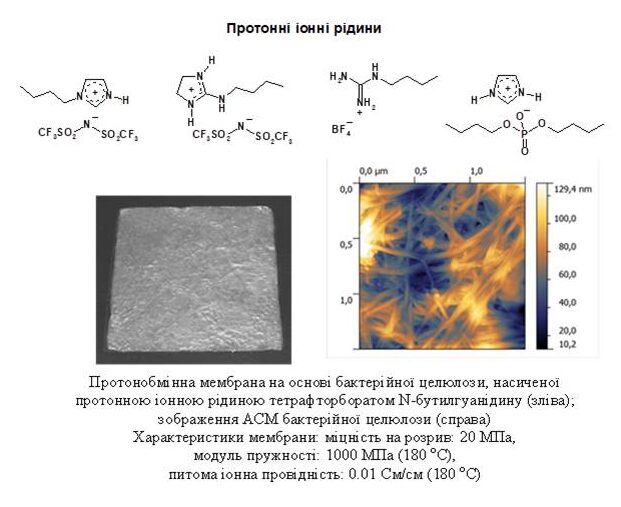
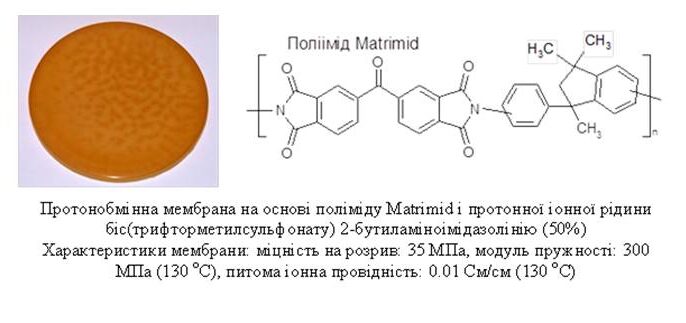
New hydrophobic cationic biocides based on long-chain onium salts have been synthesised, which include cations 1-dodecylpyridinium, 1-dodecyl-3-methylimidazolium, 1,3-didodecylimidazolium, dodecyltriphenylphosphonium and anions dodecylbenzenesulfonate, p-toluenesulfonate, tetrafluoroborate. These compounds are highly soluble in non polar solvents and can be added to industrial varnishes and paints. Protective polymer coatings based on commercial epoxy resins, alkyd (pentaphthalic) and chlorinated vinyl enamels containing 10–30% hydrophobic onium salts have been obtained. It has been established that the modified coatings do not release biocidal impurities into water, exhibit high resistance to the formation of microbial biofilms on the surface, as well as to biofouling by freshwater macroorganisms. Hydrophobic onium salts are promising antifouling agents for obtaining environmentally safe protective coatings for underwater metal structures.
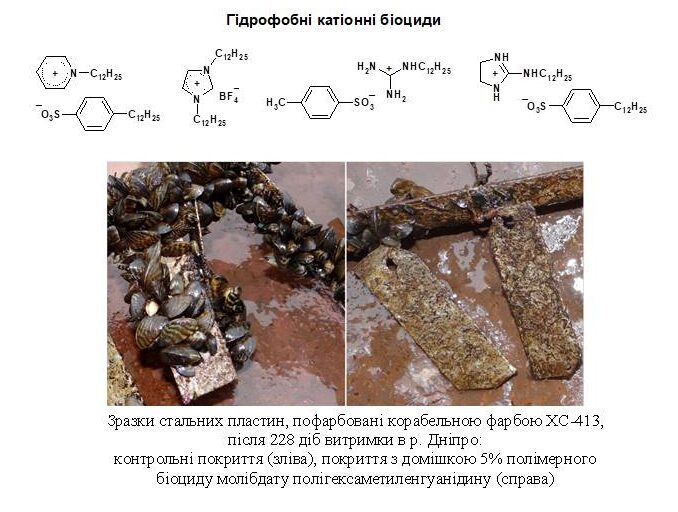
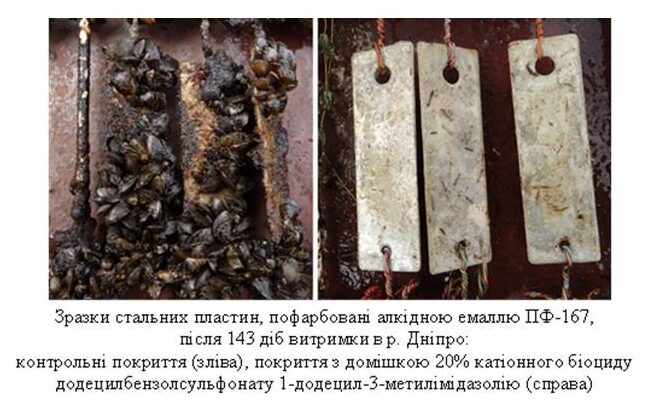
New environmentally safe plasticisers for polyvinyl chloride based on tertiary amides of fatty acids (lauric, sebacic, undecenoic, oleic) have been synthesised. The compounds effectively reduce the glass transition temperature (Tg) of polyvinyl chloride (by 70-90 °C) at a content of 20-30% and have high resistance to migration and release into water. The main advantage of amide plasticisers over traditional ester plasticisers is their high resistance to microbiological degradation under the action of fungi. The use of new plasticisers can significantly extend the service life of flexible polyvinyl chloride products for technical, medical and domestic use.
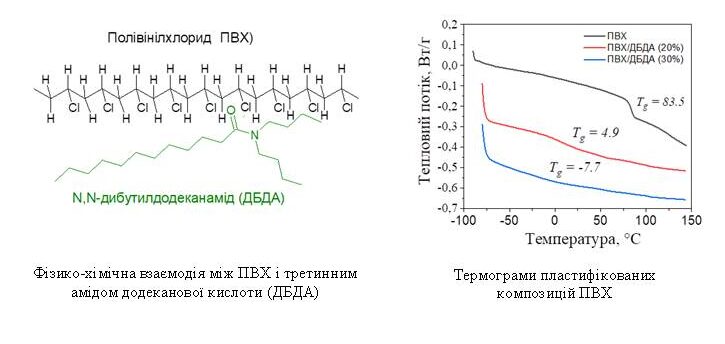
Multilayer composite materials based on glass fabric and modified phenol-formaldehyde resins have been obtained. Polymer composites combine low density (1.6 g/cm3) and high mechanical strength. The flexural modulus of the obtained glass-reinforced plastics is 33–36 GPa and exceeds similar indicators for traditional materials based on epoxy resins, which are significantly more expensive. The new composites have significant prospects for use as structural and heat-insulating materials in aviation and rocket technology, as well as in automotive, shipbuilding, the oil and gas industry, electrical engineering, construction, and municipal services.
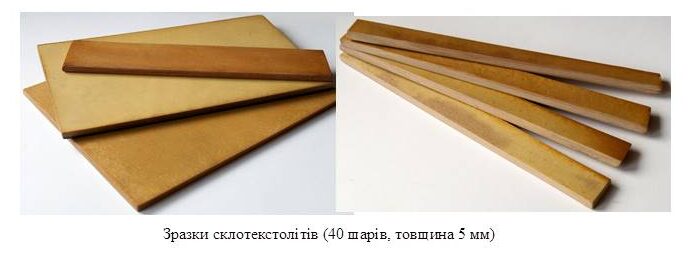

Oleg Dzhuzha
Candidate of Chemical Sciences, Research Fellow
https://orcid.org/0000-0003-4572-4769
https://www.researchgate.net/profile/Oleg-Dzhuzha
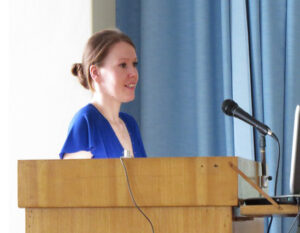
Olesya Aksenovska
Candidate of Chemical Sciences, Junior Research Fellow
https://orcid.org/0000-0003-2785-5255
https://www.researchgate.net/profile/Olesya-Aksenovska

Oksana Tarasyuk
Junior Research Fellow
1. Rogalsky S., Moshynets O., Dzhuzha O., Tarasyuk O., Hubina A., Darabut A.M., Lobko Y., Morozovska I., Protasov O. Bardeau J.-F., Preparation and characterization of antifouling coating based on commercial alkyd paint modified with hydrophobic cationic biocide. Journal of Coatings Technology and Research. 2024. 21(3). 939-953. https://doi.org/10.1007/s11998-023-00862-8
2. Zubova G., Melnyk H., Zaets I., Sergeyeva T., Havryliuk O., Rogalsky S., Khirunenko L., Zaika L., Ruban T., Antonenko S., Kozyrovska N. Halochromic bacterial cellulose/anthocyanins hybrid polymer film with wound-healing potential. Polymers. 2024. 16(16). 2327. https://doi.org/10.3390/polym16162327
3. Babenko L., Futorna O., Romanenko K., Smirnov O., Rogalsky S., Kosakivska I., Skwarek E.,Wiśniewska M. Exogenous N-hexanoyl-L-homoserine lactone mitigates acid rain stress effects through modulation of structural and functional changes in Triticum aestivum leaf. Applied Soil Ecology. 193. 105151. https://doi.org/10.1016/j.apsoil.2023.105151

4. Rogalsky , Hodyna D., Semenyuta I., Frasinyuk M., Tarasyuk O., Riabov S., Kobrina L., Tetko I., Metelytsia L. Antibacterial activity of 1-dodecylpyridinium tetrafluoroborate and its inclusion complex with sulfobutyl ether-b-cyclodextrin against MDR Acinetobacter baumannii strains. Innovative Biosystems and Bioengineering. 2023. Vol.7(4). 25-3. doi: 10.20535/ibb.2023.7.4.288529
5. Talaniuk V., Godzierz M., Vashchuk A., Iurhenko M., Chaber P., Sikorska W., Kobyliukh A., Demchenko V., Rogalsky S., Szeluga U., Adamus G., Development of polyhydroxybutyrate - based packaging films and methods to their ultrasonic welding. Materials. 16(20). 6617. https://doi.org/10.3390/ma16206617
6. Rogalsky S., Tarasyuk O., Vashchuk A., Dzhuzha O., Cherniavska T., Makhno S. Thermophysical properties and ionic conductivity of new imidazolium based protic ionic liquids. Journal of Molecular Liquids. 382. 121942. https://doi.org/10.1016/j.molliq.2023.121942
7. Lishchuk P., Vashchuk A., Rogalsky S., Chepela L., Borovyi M., Lacroix D., Isaiev M. Thermal transport properties of porous silicon filled by ionic liquid nanocomposite system. Scientific Reports. 2023. 13. https://doi.org/10.1038/s41598-023-32834-8
8. Rogalsky S., Tarasyuk O., Babkina N., Makhno S., Pertko O., Povazhnyi V., Cherniavska T., Fatyeyeva K. Fabrication of new proton conducting membrane for fuel cell applications based on porous polyimide Matrimid® and hydrophobic protic ionic liquid. Journal of Applied Polymer Science. 140(15). e53731 https://doi.org/10.1002/app.53731
9. Rogalsky S., Tarasyuk O., Dzhuzha O., Hodyna D., Cherniavska T., Hubina A., Filonenko M., Metelytsia L. Evaluation of N,N-dibutylolelamide as a bifunctional additive for poly(vinyl chloride). Colloid and Polymer Science. 300. 1405-1412 https://doi.org/10.1007/s00396-022-05038-1
10. Rogalsky S., Tarasyuk O., Vashchuk A., Davydenko V., Dzhuzha O., Motrunich S., Cherniavska T., Papeikin O., Bodachivska L., Bardeau J.-F. Synthesis and evaluation of N,N-dibutylundecenamide as new eco-friendly plasticizer for polyvinyl chloride. Journal of Materials Science. 57. 6102-6114 https://doi.org/10.1007/s10853-022-07006-0
11. Moshynets O., Baranovskyi T., Iungin O., Kysil N., Metelytsia L., Pokholenko I., Potochilova , Potters G., Rudnieva K., Rymar S., Semenyuta I., Spiers A., Tarasyuk O., Rogalsky S. eDNA Inactivation and Biofilm Inhibition by the Polymeric Biocide Polyhexamethylene Guanidine Hydrochloride (PHMG-Cl). International Journal of Molecular Sciences. 2022. 23(2). 731. https://doi.org/10.3390/ijms23020731
12. Sergiy Rogalsky, Jean-François Bardeau, Lyudmila Lyoshina, Olga Bulko, Oksana Tarasyuk, Oleg Dzhuzha, Tetiana Cherniavska, Valeriy Kremenitsky, Larisa Kobrina, Sergii Riabov. New promising antimicrobial material based on thermoplastic polyurethane modified with polymeric biocide polyhexamethylene guanidine hydrochloride. Materials Chemistry and Physics. 2021. Vol.267. 124682. https://doi.org/10.1016/j.matchemphys.2021.124682
13. Rogalsky , Bardeau J.-F., Makhno S., Tarasyuk O., Babkina N., Cherniavska Y., Filonenko M., Fatyeyeva K. New polymer-electrolyte membrane for medium-temperature fuel cell applications based on cross-linked polyimide Matrimid and hydrophobic protic ionic liquid. Materials Today Chemistry. 2021. 20. 100453. https://doi.org/10.1016/j.mtchem.2021.100453
14. Trush M., Metelytsia L., Semenyuta I., Kalashnikova L., Papeykin O., Venger I., Tarasyuk O., Bodachivska L., Blagodatnyi V., Rogalsky S. Reduced ecotoxicity and improved biodegradability of cationic biocides based on ester-functionalized pyridinium ionic Environmental Science and Pollution Research. 2019. 26(5). 4878-4889 doi:10.1007/s11356-018-3924-8
15. Moshynets Olena, Bardeau Jean-Francois, Tarasyuk Oksana, Makhno Stanislav, Cherniavska Tetiana, Dzhuzha Oleg, Potters Geert, Rogalsky Sergiy Anti-biofilm activity of polyamide 11 modified with thermally stable polymeric biocide polyhexamethylene guanidine 2- International Journal of Molecular Sciences.2019. 20(2). 348. https://doi.org/10.3390/ijms20020348
16. Moshynets O.V., Babenko L.M., Rogalsky S.P., Iungin O.S., Foster J., Kosakivska I.V., Potters G., Spierse A.J., Priming winter wheat seeds with the bacterial quorum sensing signal N-hexanoyl-L-homoserine lactone (C6-HSL) shows potential to improve plant growth and seed PlosOne. 2019. 14(2). e0209460. https://doi.org/10.1371/journal.pone.0209460
17. Sergiy Rogalsky, Jean-François Bardeau, Stanislav Makhno, Natalia Babkina, Oksana Tarasyuk, Tetiana Cherniavska, Iryna Orlovska, Natalia Kozyrovska, Olexander Brovko New proton conducting membrane based on bacterial cellulose/polyaniline nanocomposite film impregnated with guanidinium-based ionic Polymer. 2018. 142. 183–195. https://doi.org/10.1016/j.polymer.2018.03.032

18. Alexander Protasov, Jean-Francois Bardeau, Irina Morozovskaya, Mariia Boretska, Tetiana Cherniavska, Lyudmyla Petrus, Oksana Tarasyuk, Larisa Metelytsia, Iryna Kopernyk, Larisa Kalashnikova, Oleg Dzhuzha, Sergiy Rogalsky. New promising antifouling agent based on polymeric biocide polyhexamethylene guanidine Environmental Toxicology and Chemistry. 2017. 36 (9). 2543–2551. https://doi.org/10.1002/etc.3782
19. Sergiy Rogalsky, Jean-Francois Bardeau, Hao Wu, Lyudmila Lyoshina, Olga Bulko, Oksana Tarasyuk, Stanislav Makhno, Tetiana Cherniavska, Yuriy Kyselov, Joseph H. Koo Structural, thermal and antibacterial properties of polyamide 11/polymeric biocide polyhexamethylene guanidine dodecylbenzenesulfonate Journal of Materials Science. 2016. 51. 7716–7730. http://dx.doi.org/10.1007/s10853-016-0163-6
20. Diana Hodyna, Jean-Francois Bardeau, Larisa Metelytsia, Sergii Riabov, Larisa Kobrina, Svitlana Laptiy, Larisa Kalashnikova, Valeriy Parkhomenko, Oksana Tarasyuk, Sergiy Efficient antimicrobial activity and reduced toxicity of 1-dodecyl-3-methyl-imidazolium tetrafluoroborate ionic liquid/b-cyclodextrin complex. Chemical Engineering Journal. 2016. 284. 1136–1145. https://doi.org/10.1016/j.cej.2015.09.041
University of Rouen, France. Laboratory of Polymers, Biopolymers and Surfaces.
Research areas:
Publications:


Institute of Molecules and Materials, University of Le Mans, France.
Research areas: new antimicrobial polymer composites based on polydimethylsiloxane and cationic biocides.
Publications:

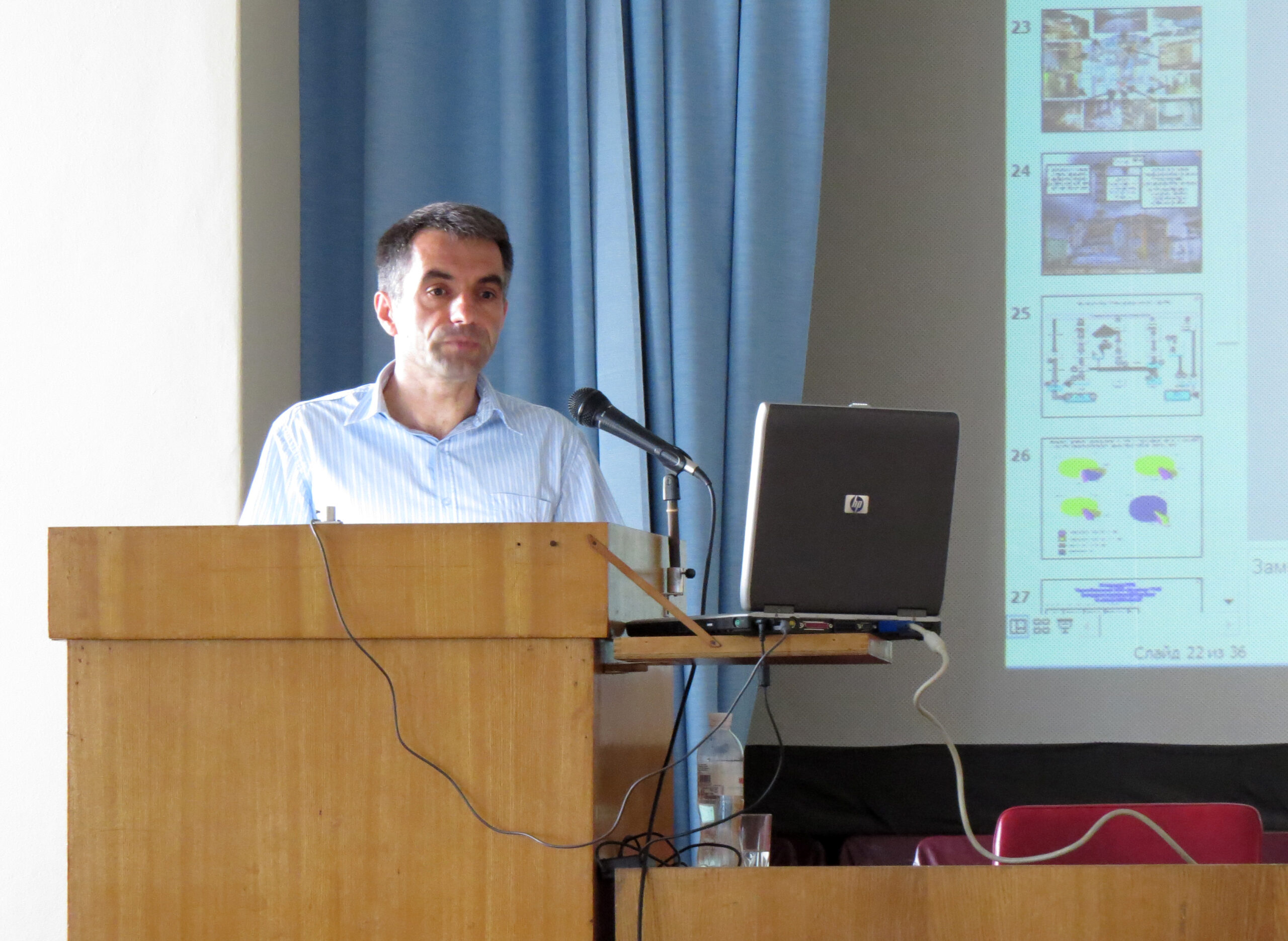
S. P. Rogalsky during a speech at the defense of O. A. Aksenovska's dissertation (Kyiv, May 2014)

S. P. Rogalsky and O. P. Tarasyuk in the Laboratory of Polymers, Biopolymers and Surfaces of the University of Rouen (France) (May 2016).
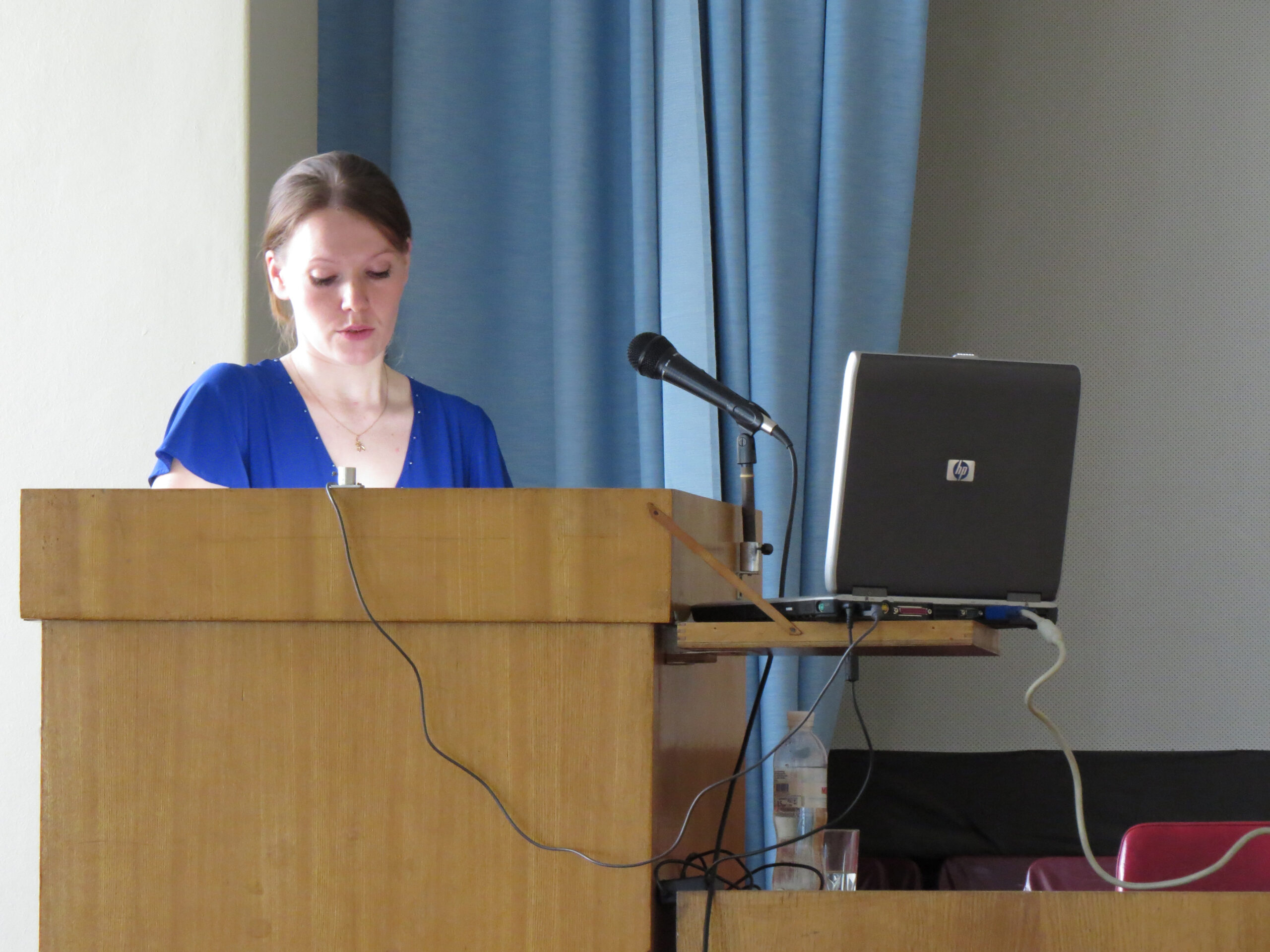
O. A. Aksenovska during the defense of her PhD thesis (Kyiv, May 2014).

O. V. Dzhuzha, V. I. Parkhomenko and O. P. Tarasyuk at the poster session of the All-Ukrainian Conference “Chemistry, Physics and Surface Technology” (Kyiv, May 2015).

O. A. Aksenovska and O. P. Tarasyuk at the 1st Ukrainian Scientific Conference “Kukhariv Chemical Readings” (Kyiv, January 2019)
V.P. Kukhar Institute
of Bioorganic Chemistry and Petrochemistry
NAS of Ukraine
© 2025 IBOPC NAS of Ukraine